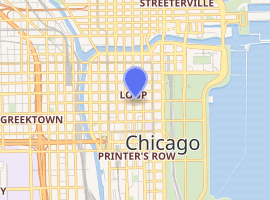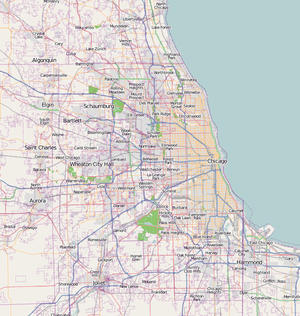Inland Steel Building
The Inland Steel Building is a skyscraper located at 30 W. Monroe Street in Chicago, Illinois. It is one of the city's defining commercial high-rises of the post-World War II era of modern architecture.[1][4] Its principal designers were Bruce Graham and Walter Netsch of the Skidmore, Owings & Merrill architecture firm.[1] The building is managed and leased by MB Real Estate. The Inland Steel Building was designated a Chicago Landmark in 1998.[1]
| Inland Steel Building | |
|---|---|
 | |

| |
| General information | |
| Location | 30 W. Monroe Street[1] Chicago, Illinois |
| Coordinates | 41.8810°N 87.6291°W |
| Construction started | 1956 |
| Completed | 1957[1] |
| Height | |
| Roof | 332 feet (101.2 m)[2] |
| Design and construction | |
| Architect | Skidmore, Owings & Merrill[1] |
| Structural engineer | Skidmore, Owings & Merrill |
| References | |
Inland Steel Building | |
   | |
| Location | 30 W. Monroe St., Chicago, Illinois |
| Coordinates | 41°52′51″N 87°37′43″W |
| Area | 0.5 acres (0.2 ha) |
| Built | 1958 |
| Architect | Skidmore, Owings & Merrill; Graham, Bruce & Walter Netsch |
| Architectural style | International Style |
| NRHP reference No. | 09000024[3] |
| Added to NRHP | February 18, 2009 |
Architecture
The use of brushed stainless steel cladding reflects the corporation that commissioned the building as its headquarters, the Inland Steel Company.[1]
The placement of all structural columns on the building's perimeter—and the consolidation of elevators and other service functions in a separate tower—allowed for a highly flexible interior floor layout with no interior columns.[1] This design is a good example of the widely held principle of the era, "form follows function" (Louis Sullivan). The lobby features a sculpture of gold, stainless steel and enameled copper by Richard Lippold entitled Radiant I.[5]
The Inland Steel Building was designated a Chicago Landmark on October 7, 1998.[1]
The building would later serve as the prototype for SOM’s much larger One Chase Manhattan Plaza in New York City, completed in 1961. Key architectural and structural concepts incorporated in the building influenced those used in the design and construction of the Cooperative Insurance Tower in Manchester, UK (completed 1962).
References
- "Inland Steel Building". City of Chicago Department of Planning and Development, Landmarks Division. 2003. Retrieved 2012-12-16.
- "Inland Steel Building". Emporis Corporation. Retrieved 2008-02-08.
- "National Register Information System". National Register of Historic Places. National Park Service. July 9, 2010.
- Schulze, Franz & Harrington, Kevin (2003). Chicago's Famous Buildings (5th ed.) Chicago: University of Chicago Press, p. 75. ISBN 0-226-74066-8.
- Marter, Joan. The Grove Encyclopedia of American Art, (Google Books link), Oxford University Press, 2011, pp. 172-73, (ISBN 0195335791), (ISBN 9780195335798).
External links
![]()